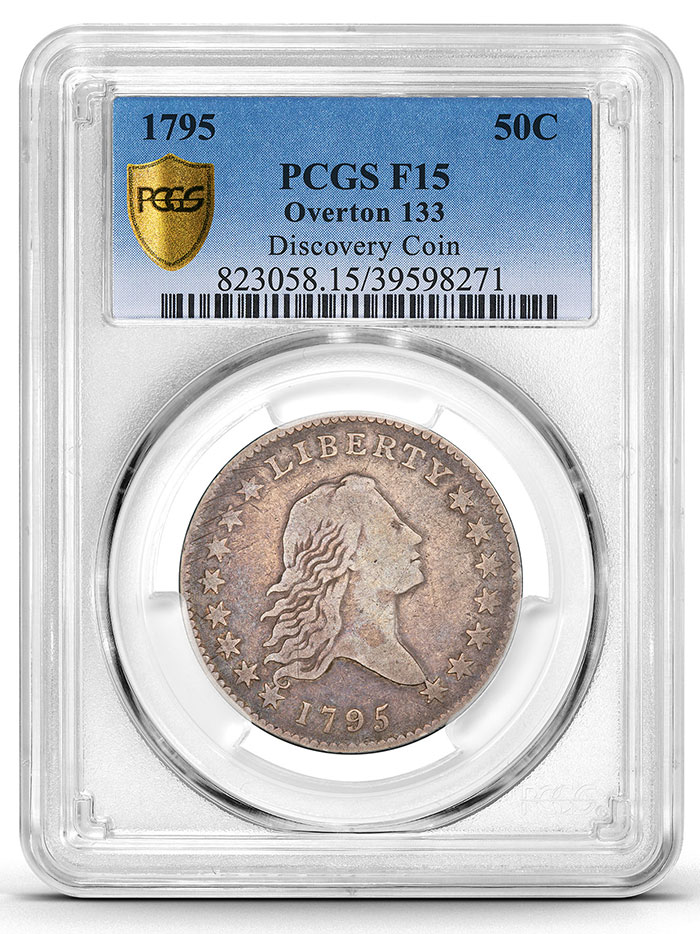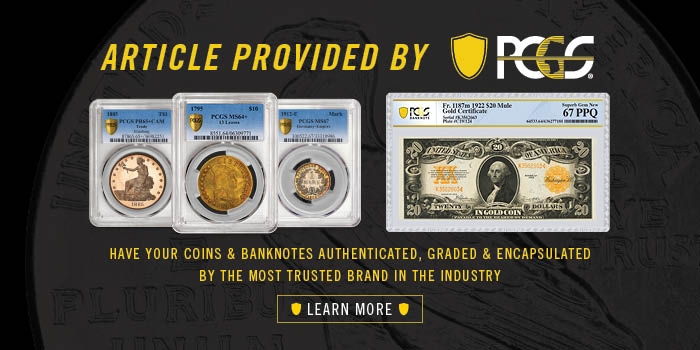New 1795 Flowing Hair Half Dollar Graded by PCGS as an F15 and Designated a “Discovery Coin”
It still pays to scrutinize all coins for something new or unusual, even those belonging to a series as well studied as the Flowing Hair Half Dollar. Struck by the United States Mint from 1794 through 1795, Flowing Hair Half Dollars have been the lifelong subject of study for numismatic specialists for well more than a century.
The coin has been profiled by coin scholars in journals, books, and magazines of all numismatic manner, and serving as an authoritative review of the series and its many varieties is a tome known as Early Half Dollar Die Varieties 1794-1836. Originally published in 1967 by Al C. Overton, the book has been updated over the years by Donald L. Parsley and now encompasses nearly 700 pages of knowledge and information as compiled over many decades of exhaustive research.
Now the iconic book may need another revision.
A new die marriage has been attributed to the 1795 Flowing Hair Half Dollar and is formally designated as Overton 133 – the 33rd distinct die marriage or die variety officially cataloged across all 1795 Flowing Hair Half Dollars. The discovery coin was recently graded as such by PCGS and represents a major milestone in the numismatic hobby for various reasons.

Notably, it is the first new die marriage discovered on a 1795 Flowing Hair Half Dollar in at least 91 years. It is also indicative of the startling fact that, somehow, one of the most popular early American coin series has yielded a previously unrecognized die marriage.
This is not to suggest that recent die marriage discoveries of the Flowing Hair Half Dollar are totally unheard of. According to W. David Perkins, the longtime Flowing Hair and Draped Bust expert and coin dealer who submitted the newly attributed 1795 Overton 133 Half Dollar to PCGS, only three Flowing Hair Half Dollars have been granted new Overton variety designations in the last 50 years, and all three are dated 1794. Other early American silver coins have also given up some previously undocumented die marriages in recent years.
“The last 1795 Flowing Hair Half Dollar die marriage was discovered somewhere between 1881 and 1929,” says Perkins. The earlier date references the publication a thorough auction catalog created for the 1881 Haseltine Type Tale Sale, which offered a full range of all then-known Flowing Half Dollar die marriages; the latter date is when M.L. Beistle published his 1929 volume, A Register of Half Dollar Die Varieties and Sub-Varieties.
The previous 1795 Half Dollar die marriage discovery, O-132, was until recently the only “new” Overton variety known for that issue going back to 1881.
“There are only two examples of O-132 known today, one of which is known but has not been seen in many decades,” expounds Perkins.
Diagnostics for the 1795 Overton 133 Flowing Hair Half Dollar
What makes the 1795 Overton 133 Flowing Hair Half Dollar different from the other 32 die marriages recognized for the date?
“First, let’s look at what similarities exist between the newly discovered die marriage, 1795 O-133, and the other 31 known 1795 Flowing Hair Half Dollar varieties – O-118 is unknown and probably does not exist. Each obverse working die was started by impressing the portrait of Liberty using a master ‘hub die.’ Similarly, each reverse working die received an impression of the small eagle.”
Perkins says that all working dies at the time were completed individually, with dentils, stars, letters, and numbers punched by hand – and even branches, leaves, and berries were inscribed in a similar way.

“Each working die was unique, each having slightly different placements of these devices relative to one another.”
For the 1795 mintage of Flowing Hair Half Dollars, numismatic experts know of 20 obverse dies and 22 reverse dies that resulted in 32 different die marriages or combinations of obverse and reverse die matings.
“Interestingly, five of the 1795 die marriages share Overton’s “Reverse N,” Overton 117, 120, 121, 122, and 133,” Perkins elucidates. “However, each was produced with a different obverse die. Until the discovery of O-133, only Overton’s “Obverse 13” used for O-122 had the features of Star 1 piercing the lowest curl and Star 15 touching the bust. Also, O-122 had been the only known reverse with a curving die crack at ‘MERICA.’ O-133 also has this crack, but it is lighter with no die chip where it crosses the leaf below the ‘C’ in ‘AMERICA.’ Most collectors, researchers, or dealers would note Reverse ‘N,’ observe Star 1 piercing the lowest curl and Star 15 touching the point of the bust and conclude ‘O-122.’”
So, what definitively distinguishes the O-133 from the O-122?
It is the position of the “T” in “LIBERTY.” For the O-133, the “T” tilts to the left as compared to the “R” and “Y”. Perkins says that if a line were drawn through the center of the T, it would point to the upper edge of the dentil above it. Meanwhile, the O-122 shows the “T” titled slightly to the right relative to the “R” and “Y”, and a line inscribed through the center of the “T” would aim right for the center of the dentil just above. Moreover, Star 2 is further from the second curl on the O-133 than it appears on the O-122.
Still, the longtime Flowing Hair expert says there is just one key diagnostic for picking out the O-133.
“The position of the ‘T’ in ‘LIBERTY’ is all you need to attribute the obverse of O-133.”
The O-133 Steps Out
Nobody has been knowingly sitting on the 1795 Overton-133 Flowing Hair Half Dollar for very long. The rare die marriage was discovered only in May 2020 and Perkins bought the coin just weeks later in June.
“That’s what makes it so exciting, being almost 140 years after the Haseltine Type Table Sale in 1881. It was out there, and nobody discovered it until a few months ago!”
Making this discovery even more awe-inspiring is how infrequently such major finds happen and are fully confirmed. As mentioned, the Overton-133 is the first 1795 Flowing Hair Half Dollar discovered in at least 91 years. But what about 1794 Flowing Hair Half Dollars? In the past five decades, Perkins says just three were discovered, including the unique 1794 O-109 found by Robert Hilt in 1976; the O-110 uncovered by Jules Reiver in 1982 and yielding a total of just 12 specimens to date; and the unique O-111 located by Andrew Pollack at Bowers & Merena in 1993.
Expanding into other areas of large-size Flowing Hair and Draped Bust coinage, Perkins says that in 1988 there were 13 new die marriages among those two major types since the Haseltine Type Table Sale 107 years earlier in 1881, and five of those were 1795 Flowing Hair Dollars.
“This works out to a little more than one new discovery per decade,” annotates Perkins. “Two additional Draped Bust Dollar die marriages have been discovered since, including the 1795 BB-126, B-34 and 1803 BBB-257, B-8.”
Making it Official
While new varieties have been discovered and attributed since the pre-slabbing era of coin cabinets, these days third-party grading is a staple, offering collectors security and peace of mind at a time when counterfeiters are more sophisticated than ever. So, Perkins wasted little time in submitting the coin to PCGS to ensure it was the real deal and to have the coin officially recognized as a “Discovery Coin” and graded in a secure holder.
“I’d worked with PCGS before on the discovery of a new die marriage for the 1803 Draped Bust, Small Eagle Dollar (BB-257, B-8) in March 2015,” he recalls. “A graded coin in a PCGS holder is preferred by many, especially those collectors building PCGS Registry Sets. When I contacted PCGS President Brett Charville about this opportunity he replied to my note only a few minutes after receiving it, and PCGS Director of Numismatic Education and Outreach Steve Feltner was equally as quick responding,” he adds. “The PCGS team was great to work with.”
The O-133 could soon be on its way into the hands of a new collector.
“I may sell it privately through my business, W. David Perkins Numismatics, or possibly in a one-lot sealed auction bid sale, which I have done in the past,” notes the longtime dealer. “I’ve been contacted by a few interested collectors and dealers already.”
While the coin is sure to find a good home before too long, Perkins has nothing but hearty congratulations to offer the coin’s anonymous previous owner.
“It was quite a thrill for him after 30-plus years of looking at and collecting the half dollars of 1794 to 1836 by die marriage.”
And Perkins remarks that while there may have been some degree of luck involved in this discovery, it was just as much a tale of patience, persistence, and knowledge.
“With the advent of eBay and online auctions, there are more coins available to look at and attribute. Those consistently checking for new die varieties have the best chance. You never know when or where a new die marriage – or example of a rare die marriage – will show up!”
* * *






